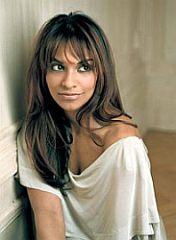
There comes a time in every alluring young female singer’s life when it is time to grow up. The precocious Cecilia Bartoli, who caused a sensation at age 23, concertized with little-girl bows in her hair until at least her late 20s. Similarly, soprano Danielle de Niese, who at age 18 became the youngest singer ever to enter the Metropolitan Opera (now Lindemann) Young Artist Program, and who made her Met debut as Mozart’s Barbarina a year later, still teases and flirts her way through songs and arias as if she were a teenager trying to make it by every means possible. But where the young Bartoli’s youthful ardor never undermined her artistic maturity, the beautiful, slender de Niese’s modus operandi at her Cal Performances debut recital in UC Berkeley’s Hertz Hall on Sunday afternoon raised questions as to how she chooses to use her God-given gifts.
As much as the Australian-born soprano’s gorgeous, caramel-colored skin points to her Sri Lankan and Dutch parentage, her Valley Girl speaking accent screams “schooled in L.A.” As the host of a weekly arts showcase for teenagers on Los Angeles television, de Niese’s fine voice and ebullient personality helped win her an Emmy at only age 16. And studies in drama and dance at the Colburn School in Los Angeles helped equip her for her 2005 Glyndebourne all-singing, all-dancing, showstopping portrayal of Cleopatra in Handel’s opera Julius Caesar.
Now 29, de Niese still displays a host of little-girl mannerisms. She sighed several times before and after song sets, as if to say, “Don’t you see how hard this is? Please love me.” She played with her hair, fidgeted much too much with her dress, and threw a host of winning smiles at her audience. It was certainly charming and seductive. You really wanted to love her. But it raised a question: Where have all her years of training and success left her as an artist?
Almost There
De Niese’s first-half outfit was a gorgeous maroon dress whose Greco-Roman folds, complemented by oversized gold jewelry around neck and wrist and by sparkly gold heels, seemed tailor-made for her opening two arias from Handel’s Semele. In “Endless Pleasure” and “Myself I Shall Adore,” she displayed a voice that, while somewhat thin on the bottom, bloomed substantially in the upper range. The bloom, however, was accomplished by a choice to increase vocal body at the expense of tonal purity. (She was, after all, schooled at the Met rather than in a European Baroque jewel-box theater.)
As lovely and secure as the singing was, with occasional flashes of brilliance at the very top, the lack of clarity in her trill and inability to sing lightly in the upper ranges limited listeners’ pleasure. Although Kathleen Battle’s recording of these arias displays a similar tendency, she possessed a silvery fineness of line seldom heard from de Niese. As for the incomparable technical brilliance, radiance, and sly humor that Beverly Sills displayed in her 1968 live recording of Semele, there is no comparison.
On the other hand, de Niese was simply adorable. Moving her body with total freedom, and making enough self-centered, seductive faces to fill a DVD titled How to Beguile, she presented Handel as few could, or can.
Unfortunately, her lack of purity and simplicity of utterance detracted from “Det syng” (Enticement), the first of five excerpts from Edvard Grieg’s Haugtussa (The mountain maid). Similarly, “Blabaer-Li” (Blueberry Hill) lacked innocence. At one point, de Niese sounded like a spoiled little kid. The feeling of not quite getting there persisted in “Vond Dag” (Sorrowful day), in which tears became indistinguishable from pouting. And in “Verborgenheit” (Seclusion), the first of five Hugo Wolf songs that followed, it was hard to resist feeling that perhaps de Niese has not yet suffered enough to truthfully convey pain and emptiness.
For all this, the soprano certainly did give her all. She poured voice, attention, and focus into her debut, and that demands appreciation. At her best in Wolf’s “In dem Schatten meiner Locken” (In the shadow of my locks) and “Ich hab’ in Penna einen Liebsten Wohnen” (I have a lover who lives in Penna), her willingness to unapologetically embrace her inner child and outer flirt made for unrestrained interpretations that great lieder singers of the past only dared hint at.
Yet in songs that called for lightness and subtlety, such as “Il vole” (He flies) and “Fleurs” (Flowers), from Poulenc’s song cycle Fiançailles pour rire (Whimsical betrothal), and in all three of the Bizet numbers she performed, the singing did not match the allure of the fabulous pink coral confection of a dress in which she presented the second half of the program.
Curious Ending
Questions about de Niese’s technique persisted throughout the afternoon. She seemed either unable or unwilling to sing softly in the upper ranges. Instead of the subtlety and restraint that are hallmarks of a great song recitalist, she mostly went for the big effect. Barber’s Sleep Now, for example, began with beautiful calm, but soon swelled to unwarranted operatic extremes. To contrast de Niese’s “Fleurs” with Arleen Auger’s or Catherine Dubosc’s recordings of the songs makes you wonder where all the flowers have gone.
Ken Noda’s accompaniment certainly didn’t help. He may be musical assistant to James Levine at the Met, but his clipped staccatos, sounded with surgical precision, hinted at too many cups of coffee. It’s almost as if de Niese has built an adoring, protective circle around her that is inhibiting her artistic growth.
The encores, which seemed custom-fit for de Niese, were a surprising near miss. Cole Porter’s “I hate men!” from Kiss Me Kate should have been a scream, but it sounded far too operatic, and lacked the ludicrous intensity of anger that Kathryn Grayson brought to the Technicolor screen. William Bolcom’s “Amor” seemed an ideal show capper, but de Niese couldn’t seem to figure out who she was in it. Did she really not understand why the judge dropped his gavel and whispered “amor”? For inexplicable reasons, the singer who achieved fame for her teasing portrayal of Cleopatra came up short in the teasing department.

